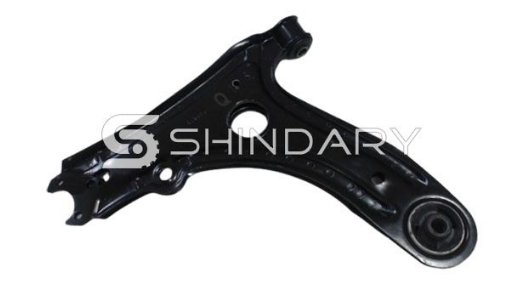Copyright © Shindary Automotive Parts Co., Ltd. All Rights Reserved
A swing arm suspension for automotive vehicle has a suspension arm pivotably connected to a suspension member for rotation about a substantially horizontal pivot axis. A lateral rod is connected to the suspension arm at one end thereof via a bushing and to a suspension member at the other end via another bushing.
1. The main purpose of a swing arm is supporting the vehicle body and shock absorber. It also plays a cushioning role during shock absorber movement. The shock absorber effectively assists with the function of the lower suspension;
2. The lower swing arm is responsible for load bearing and steering. A rubber sleeve is used to fix the lower swing arm while connecting the shock absorber;
3. A damaged rubber sleeve can result in abnormal sound during drive, compromised damping effect, and more difficult steering. In serious cases, the swing arm may break, causing loss of control of the car and an accident. Hence, a damaged rubber sleeve should be repaired as soon as possible.

Swing arms come in various designs, each suited to different vehicle types and performance requirements. The most common types include single-arm (mono-arm), double-arm (double wishbone), and trailing arm designs.
The single-arm or mono-arm design is typically found in motorcycles and some rear suspension systems of cars. It consists of a single control arm that supports the wheel hub. This design offers simplicity and reduced weight but may not provide the same level of stability as more complex designs.
The double-arm or double wishbone design is widely used in both front and rear suspensions of cars. It consists of two arms, an upper arm, and a lower arm, forming a wishbone shape. This design offers superior stability, precise control, and better handling characteristics. It allows for more accurate alignment adjustments and improved suspension geometry.
The trailing arm design is commonly used in rear suspensions, particularly in compact and economy cars. It features arms that extend longitudinally from the chassis to the wheel hub. This design is relatively simple and cost-effective but may not offer the same level of performance as double wishbone suspensions.
Proper maintenance of the swing arm is essential for ensuring vehicle safety and performance. Over time, swing arms and their associated components can wear out or become damaged, leading to alignment issues, reduced ride comfort, and compromised handling.
Recognizing the signs of swing arm problems can help prevent more serious issues. Common indicators include:
- Uneven Tire Wear: This may indicate alignment issues caused by worn or damaged swing arms.
- Steering Vibrations: Excessive vibrations in the steering wheel can be a sign of swing arm or suspension problems.
- Clunking Noises: Unusual noises when driving over bumps or during turns may suggest loose or worn swing arm components.
Regular inspections and repairs are crucial for maintaining the integrity of the swing arm and overall suspension system. During routine maintenance, mechanics should check for signs of wear, corrosion, and damage. Replacing worn-out bushings, ball joints, and other components can restore proper function and prolong the life of the swing arm.
The swing arm is a vital component of a car's suspension system, responsible for maintaining wheel alignment, absorbing shocks, and facilitating controlled wheel movement. Understanding its functions and ensuring regular maintenance can significantly enhance vehicle performance, safety, and comfort.
For more information on swing arm maintenance or to source high-quality suspension components, contact us today. We are a reliable supplier committed to providing top-notch automotive parts and services to meet your needs.

Shindary Automotive Parts Co., Ltd.